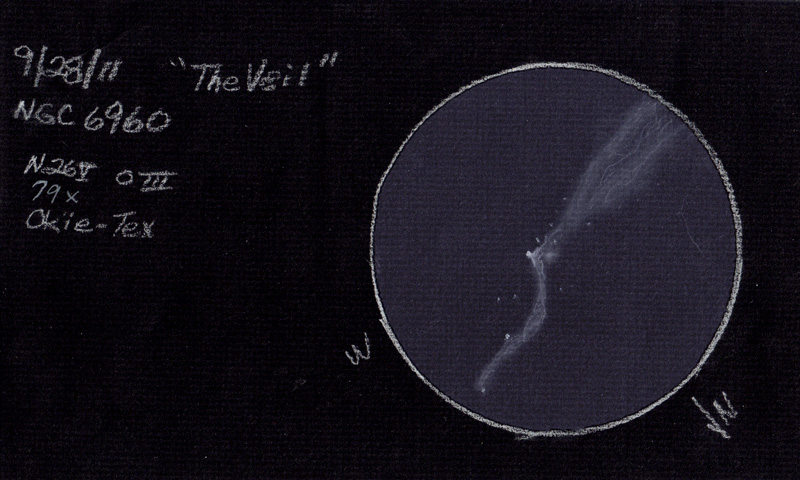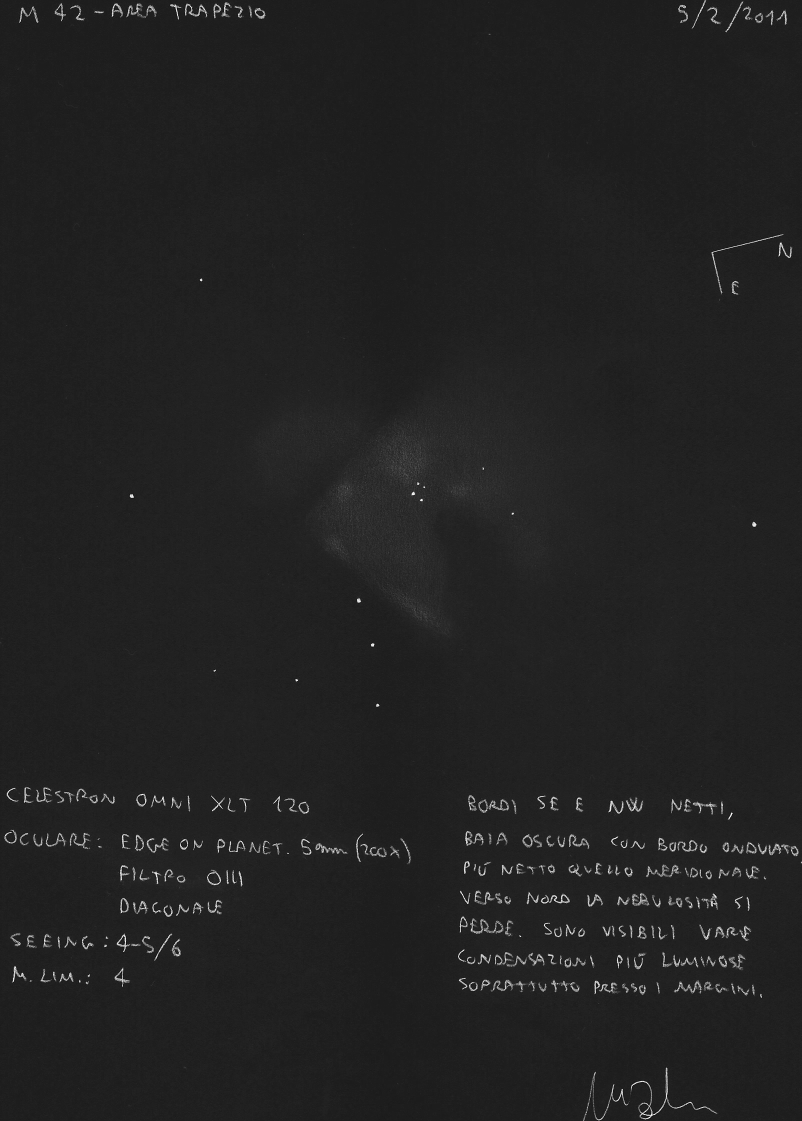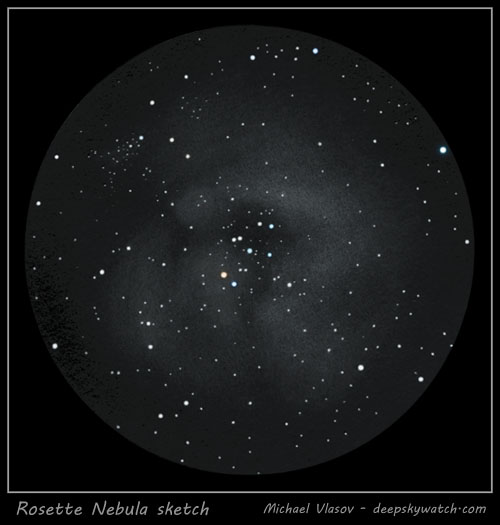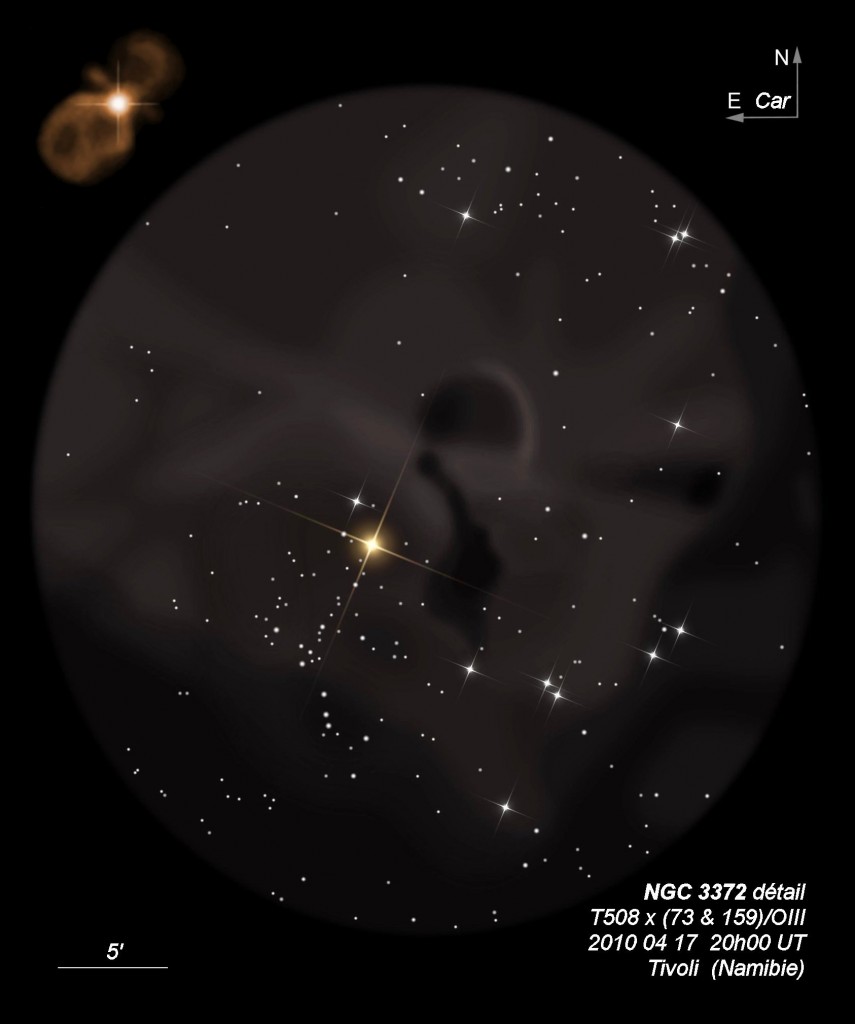
Object Name: The Western Veil – NGC6960 & 52 Cygni
Object Type: Emission Nebula and foreground star
Location: Kenton, OK (Okie-Tex Star Party 2011)
Date: September 28, 2011
Time: 0200 CDT
Media: Conte crayon and white pencil on black paper.

Object Name: M 42
Object Type: Nebula
Location: Cittadella (Italy)
Date: February 5, 2010
Media: graphite pencil, white paper, inverted in Gimp
Instrument: 120 mm achromatic refractor (f/8.3)
Eyepiece: Edge On Planetary 5 mm (200x), diagonal and O-III filter
Conditions: Visual magnitude: 4, some light pollution
This is a sketch showing the central part of the Orion Nebula, seen in a 120 mm refractor at 200x. The sky conditions were not ideal for observing the whole extent of the nebula, but the brighter Trapezium area showed several details at this magnification.
Clear skies,
Massimo

Hello,
Here is a m8 sketch I made this summer.
It was the first and last time I observed this nebula (because I observed it early and here, in Quebec, we don’t have good sky every day !).
I was alone with the radio in a blue-berry field, at Dolbeau. I remember… I saw Sagittarius constellation I and took my ipod to see which object I could see in this region… Nebulae and nebulae it had on my app ! I decided immediately to spot one of them with my 10 inch scope.
The Lagoon Nebulae
Without OIII, I easily saw the stellar cluster (NGC 6530) and I notice some nebulosity. But when I put the OIII filter… it was outstanding ! It first look like a cat footprint… My field of view did no allow me to see the entire nebulae. I wasn’t no anything about this nebulae this night and it was the main reason I drew it: When I came home and compare my sketch with picture I was just too happy 😛
Object Name: The Lagoon nebula, m8
Object Type: Emission nebulae with stellar cluster
Location: Dolbeau-Mistassini, Quebec, Canada
Date June 26-27 2011
Media: HB sketch pencil and shder brush
Instrument: Skywatcher 10 inch, 1200mm of focal length
Eyepiece: Celestron Ultima LX 13mm + Lumicon OIII filter
Michael Caouette-Mansour

“Rosette Nebula” is a large emission nebula located in Monoceros, around an open cluster NGC 2244. This is a classic star forming region, where stars from the open cluster were formed from the nebula’s material.
The cluster in the middle (NGC 2244) is very bright, and easily noticed with a naked eye under dark skies. However the nebula around it is a tougher target. It’s large, faint, and best viewed with moderate aperture and wide angle eyepieces (2.25 degrees field of view in this case). UHC filter helps a lot. The nebula has roundish structure, with diffuse and irregular edges. Under dark skies it reveals a complex structure, with a large “black hole” in middle of it, where the cluster resides. Most of it’s stars are blue or white, except the brightest yellow star on it’s edge (12 Monoceri).
At the north-east (top-right in this drawing) there is a faint, elongated open star cluster NGC 2252.
Object Name : “Rosette Nebula” (Caldwell 49) and NGC 2244
Object Type : Nebula (HII region) and open cluster.
Location: Negev desert, Israel, ~6.6 mag. sky.
Date: 25-26/11/2011 ; 03:30.
Instrument: 200mm F/5 Orion (US) Newtonian, Hyperion 31mm, UHC, 32X, 2.25° TFOV.
Media Graphite pencil sketch on a white paper. Inverted and processed in Photoshop.

Date: 2010 04 17
Place: Tivoli, Namibia
Scope: Dobson Obsession, 20”
Eyepieces: Panoptic 35mm and Nagler 16mm (nebula), nagler 9mm and 3.5mm (Eta Car)
Magnification: from 73x to 725x
Filter: Lumicon OIII (old, with H alpha included in passing band)
Duration of observation: 55 min (Eta Car) + 50 minutes (nebula)
Process: sketch with pencil on rough paper, with notes and curves of luminosity (isophotes) in a scale from 0 (black) to 10 (most luminous DSO spot in the sky)
Final process: drawing made with Paint Shop Pro
More details and drawings at www.deepsky-drawings.com.
Regards
Bertrand

Object Name: M42, M43
Object Type: Nebula
Location: Russia, Strelech’ya Polyana
Date: 23 october 2011
Media: graphite pencil on white paper, inversion and little star correction (so they’d look more round) in PhotoShop CS2
That night I actually saw the Great Nebula for the first time in normal conditions and under pretty dark skies (somewhere 5.7m stars were seen). And this sketch is the second attempt to draw it. Using my 12″ Dob it took me about 1.5 hours.
M42 looked fantastically bright, but it’s a pity I didn’t guess to put 12.5mm eyepiece instead of 25mm while sketching the brightest part, the one around trapezium, because only then the structure of nebula’s filaments was easily seen. Under the wings, the space of 10′ maybe, was filled with such dense cloud, that it reminded me of M31’s core, but lower it became more diffuse and slowly disappeared. Above M42 M43 was also visible, like a fat comma. And it seemed to me, that its tail was a little bit separated from the main body.